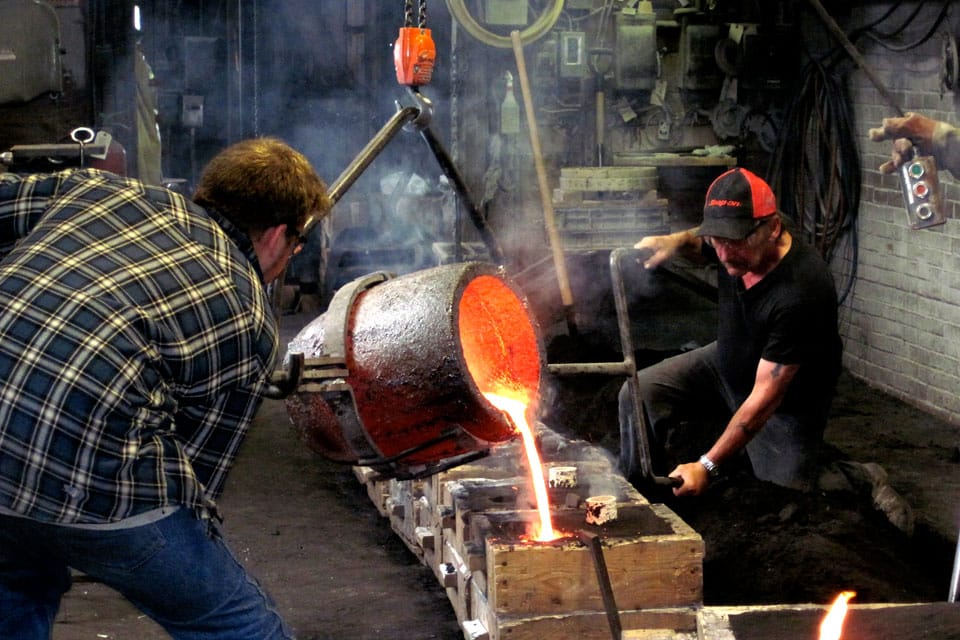
Lunenburg Foundry
In Greek mythology, the god Hephaestus was the master of all things metal on Mount Olympus. As the blacksmith of the gods, he forged all of their gear, from the winged helmet and sandals of Hermes to the bow and arrows of Eros, and he had a special kinship with metal, fire, and volcanoes. The crew of Osprey didn’t expect to encounter any of the god’s earthly apprentices while we cruised in the waters of Nova Scotia, but we did. Arrayed in an odd combination of flip-flops and safety goggles, we stood on a dirt floor and watched history take shape as molten metal poured forth from a glowing red vessel, continuing today an art form that the Lunenburg Foundry has been perfecting since 1891.
Lunenburg Industrial Foundry & Engineering has played such an integral part in North Atlantic maritime history that it’s fair to say that few ships set sail from these storied shores without at least one piece from the company on board. LIFE may be best known for its famous Atlantic Marine engines, called “one-lungers” and “make-and-breaks,” whose signature putt-putt-putts can still be heard today barking through a thick morning fog. The Foundry’s cast-iron stoves, such as the diminutive Little Cod and Sardine, still heat boat cabins around the world.
Through its remarkable history, the Foundry has evolved, along with the ships and boats that it’s helped build and fit out, from the age of wooden sail to modern ships and yachts and the restoration of Bluenose II, Canada’s flagship schooner. Today the company works with the most cutting-edge technologies to continue serving the maritime community. But in its foundry, located at the head of Lunenburg’s harbor in a shaggy, red-painted building whose sides still advertise Sherman Whaling Supplies and Lubricating and Burning Oils, men continue to cast metal using an ancient process and hand-made forms that have turned out woodstoves, engines, propellers, shafts, bells, and even a bright brass star to top a Christmas tree.
We could hear, long before we stepped through the foundry’s door, the demonic, throaty roar of the furnace. Peeking at the beast itself, we saw a squat, round platform. It looked a lot like the top of a well, but it was Hephaestus’ forge incarnate. From a hole in the center roared a flame so intense that it looked like it came from the business end of a jet fighter. Off to one side stood a box of shiny bronze ingots, stacked like dazzling cordwood.
Out in the main casting area, a row of wooden crates called mold boxes squatted on the sand-packed floor; each box was filled with compacted silica sand. Metal patterns for stuffing boxes had already been laid into the sand and extracted, leaving a precise negative form within waiting to be filled. From each box protruded a short, white PVC chimney to let heat and gases escape after the metal was poured.
All of this was fascinating, but when the three men working the pour approached us while guiding the red-hot vessel fresh from the furnace and suspended by metal clamps just off the floor, the process went straight to jaw-dropping. With few words, the three executed a perfectly choreographed dance, guiding streams of molten metal precisely into a small opening in the top of each box the way you or I might pour maple syrup from a pitcher onto pancakes. Steam and smoke spouted from the chimneys, and small jets of flame flickered from several boxes long after the pour was over.
It was the men’s quiet competence in the presence of the ferocious elements that they handled that made the whole scene appear unreal. What was everyday work for them was a wonder for us, and we were grateful for the chance to watch these sons of Hephaestus in their world of fire creating something useful, something beautiful, something alive.
This December, the Clarkes added a Lunenburg Foundry brass star to the top of Osprey‘s tree.
Check out a photo gallery of Lunenburg, Nova Scotia at our sister publication, Yachting.








